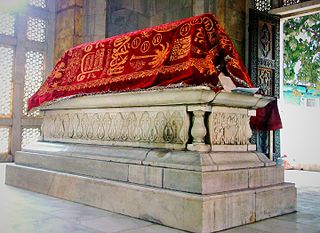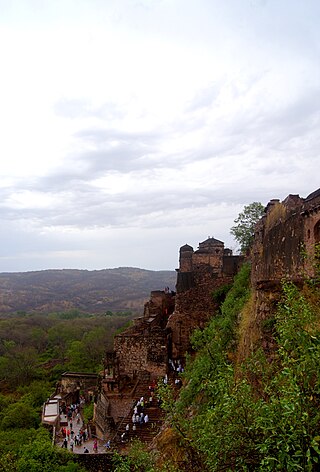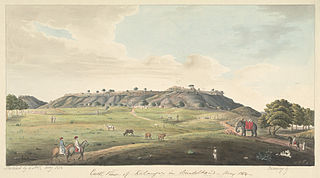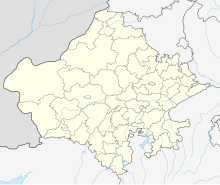
Mu'izz al-Din Muhammad ibn Sam, also known as Muhammad of Ghor or Muhammad Ghori, was a ruler from the Ghurid dynasty based in the Ghor region of what is today central Afghanistan who ruled from 1173 to 1206. Muhammad and his elder brother Ghiyath al-Din Muhammad ruled in a dyarchy until the latter's death in 1203. Ghiyath al-Din, the senior partner, governed the western Ghurid regions from his capital at Firozkoh whereas Muhammad extended Ghurid rule eastwards, laying the foundation of Islamic rule in South Asia, which lasted after him for nearly half a millennium under evolving Muslim dynasties.

Qutb ud-Din Aibak was a Turkic general of the Ghurid emperor Mu'izz ad-Din Muhammad Ghori. He was in charge of the Ghurid territories in northern India, and after Muhammad Ghori's assassination in 1206, he established his own independent rule in Lahore, and laid the foundations for the Sultanate of Delhi.

The Mamluk dynasty, or the Mamluk Sultanate, is the historiographical name or umbrella term used to refer to the three dynasties of Mamluk origin who ruled the Ghurid territories in India and subsequently, the Sultanate of Delhi, from 1206 to 1290 — the Qutbi dynasty (1206–1211), the first Ilbari or Shamsi dynasty (1211–1266) and the second Ilbari dynasty (1266–1290).

Prithviraja III, popularly known as Prithviraj Chauhan or Rai Pithora, was a king from the Chauhan (Chahamana) dynasty who ruled the territory of Sapadalaksha, with his capital at Ajmer in present-day Rajasthan in north-western India. Ascending the throne as a minor in 1177 CE, Prithviraj inherited a kingdom which stretched from Thanesar in the north to Jahazpur (Mewar) in the south, which he aimed to expand by military actions against neighbouring kingdoms, most notably defeating the Chandelas.
The Ghurid dynasty was a Persianate dynasty of eastern Iranian Tajik origin, which ruled from the 8th-century in the region of Ghor, and became an Empire from 1175 to 1215. The Ghurids were centered in the hills of the Ghor region in the present-day central Afghanistan, where they initially started out as local chiefs. They gradually converted to Sunni Islam after the conquest of Ghor by the Ghaznavid ruler Mahmud of Ghazni in 1011. The Ghurids eventually overran the Ghaznavids when Muhammad of Ghor seized Lahore and expelled the Ghaznavids from their last stronghold.

Hansi, is a city and municipal council in Hisar district in the Indian state of Haryana. It appears that at one time Hansi was larger, more prosperous and more important than Hisar. The town has several important buildings of archeological importance.

The Second Battle of Tarain was fought in 1192 between the Ghurid forces of Muhammad Ghuri and the Rajput Confederacy of Prithviraj Chauhan. It took place near Tarain, which is 110 kilometres (68 mi), north of Delhi. The battle ended in a decisive victory for the invading Ghurids and their successful penetration in north Indian plain.

Ranthambore Fort lies within the Ranthambore National Park, near the city of Sawai Madhopur in Sawai Madhopur district of Rajasthan, India. the park being the former hunting grounds of the Maharajahs of Jaipur until the time of India's Independence. It is a formidable fort having been a focal point of the historical developments of Rajasthan. The fort was constructed by Nagil Jat ruler Raja Sajraj Singh Nagil and later captured by several Rajput dynasties including Hada and Mewar and then the Delhi Sultanate captured it for a brief time. The fort provides a panoramic view of the surrounding Ranthambore National Park and is now a popular tourist attraction.
The First Battle of Tarain, also spelt as the First Battle of Taraori, was fought in 1191 between the invading Ghurid army led by Muhammad of Ghor and the Rajput Confederacy led by Prithviraj Chauhan, near Tarain. The battle ended in decisive victory for the Rajputs; however, Muhammad of Ghor managed to escape and returned to Ghazni.

Asigarh Fort, also called Hansi Fort, is located on the eastern bank of Amti lake in Hansi city of Haryana, India, about 135 km from Delhi on NH9. Spread over 30 acres, in its prime days this fort used to be in control of 80 forts in the area around it. The fort is said to be one of the most impregnable forts of ancient India and has been declared a centrally protected monument by ASI in 1937.

Vigraharāja IV, also known as Vigraharāja the Great and also Visala-deva was a king from the Chahamana (Chauhan) dynasty in north-western India, and is generally considered as one of the greatest rulers of the dynasty. He turned the Chahamana kingdom into an empire by subduing the neighbouring kingdoms of Chaulukya, Naddula, and Tomara kingdoms. He also repulsed Muslim invasions, from the Ghaznavid ruler Bahram Shah and defeated Khusrau Shah.
Udaya-simha was an Indian king belonging to the Chahamana dynasty, who ruled the area around Javalipura. The most powerful king of his dynasty, he overthrew the Chaulukya suzerainty, and became a sovereign ruler. However, some years later, he faced an invasion from the Delhi Sultanate, and became a tributary to the Sultan Iltutmish.
MalikKamāl al-Dīn "Gurg" or Kamaluddin-e Gurg, was a general of the Delhi Sultanate ruler Alauddin Khalji. He played an important role in Alauddin's conquest of the Siwana (1308) and Jalore (1311) forts. After Alauddin's death, he was sent by Malik Kafur to suppress a revolt in Gujarat, where he was killed.

The Ghurid campaigns in India were a series of invasions for 31 years (1175–1206) by the Ghurid ruler Muhammad of Ghor in the last quarter of the twelfth and early decade of the thirteenth century which lead to the widespread expansion of the Ghurid empire in the Indian subcontinent.
Jatwan was a Chief and subordinate of Prithviraj Chauhan who rebelled against Qutb ud-Din Aibak of the Delhi Sultanate in 1192 CE.

The siege of Kalinjar was a military expedition conducted by the Ghurid Empire under the leadership of Qutb-ud-din Aibak and Iltutmish against the Chandelas of Jejakabhukti in 1203. During this campaign, the Ghurids successfully captured the Kalinjar fortress after laying siege to it. The Ghurid forces emerged victorious, defeating the Chandelas, and the Chandela ruler Paramardi surrendered Kalinjar to the Ghurids.

The siege of Gwalior was a military expedition of The Ghurid Dynasty aganist the Kachchhapaghata dynasty in 1196. The Ghurids under Qutb ud-Din Aibak captured Gwalior after defeating Sulakshanapala, the King of Kachchhapaghata. Sulakshanapala surrendered to Aibak, which led to the complete end of Rajput Kachchhapaghata dynasty
The Capture of Jhain was a military expedition carried out by the Delhi Sultanate under Jalal-ud-din Khalji against the Kingdom of Ranthambore. It took place in the March of 1291 when the Delhi forces defeated the Ranthambore forces under Gurdan Saini and captured the city of Jhain.
The Khalji Raids into Magadh, was a significant military campaign of the Ghurid Empire led by the Ghurid commander Bakhtiyar Khalji. He successfully captured Bihar, incorporating it into the Ghurid Empire, before proceeding with his invasion of Bengal.













